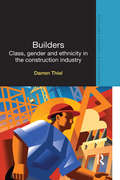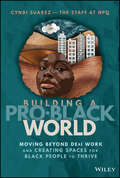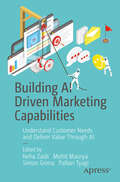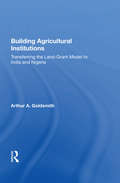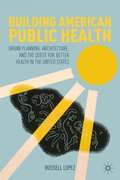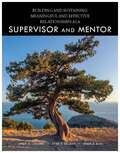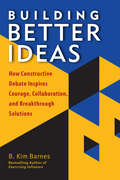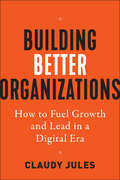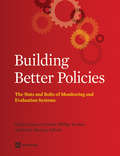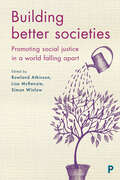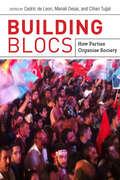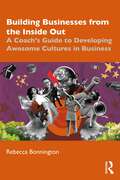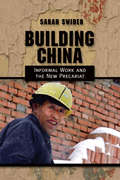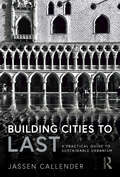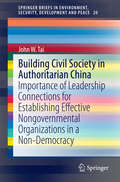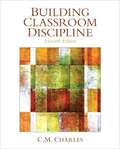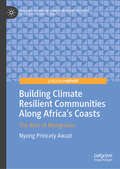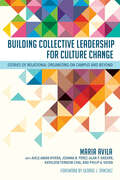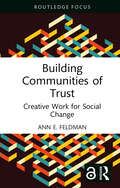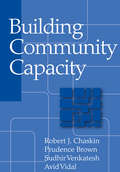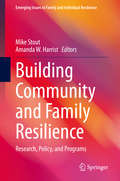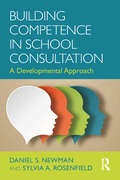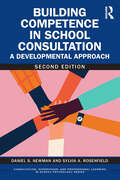- Table View
- List View
Builders: Class, Gender and Ethnicity in the Construction Industry (Routledge Advances in Ethnography)
by Darren ThielBuilding workers constitute between five and ten per cent of the total labour market in almost every country of the world. They construct, repair and maintain the vital physical infrastructure of our societies, and we rely upon and trust their achievements every day. Yet we know surprisingly little about builders, their cultures, the organization of their work or the business relations that constitute their industry. This book, based on one-year’s participant observation on a London construction site, redresses this gap in our knowledge by taking a close-up look at a section of building workers and businessmen. By examining the organizational features of the building project and describing the skill, sweat, malingering, humour and humanity of the building workers, Thiel illustrates how the builders were mostly autonomous from formal managerial control, regulating their own outputs and labour markets. This meant that the men’s ethnic, class and gender-bound cultural activities fundamentally underpinned the organization of their work and the broader construction economy, and thereby highlights the continuing centrality of class-bound culture and social stratification in a post-industrial, late modern world. Thiel outlines the on-going connections and intersections between economy, state, class and culture, ultimately showing how these factors interrelated to produce the building industry, its builders, and its buildings. Based predominately on cultural and economic sociology, this book will also be of interest to those working in the fields of gender and organizational studies; social class and inequality; migration and ethnicity; urban studies; and social identities.
Building A Pro-Black World: Moving Beyond DE&I Work and Creating Spaces for Black People to Thrive
by Nonprofit QuarterlyLearn to create a nonprofit organization and society in which Black people can thrive In Building A Pro-Black World: A Guide To Creating True Equity in The Workplace and In Life, a team of dedicated nonprofit leaders delivers a timely roadmap to building pro-Black nonprofit organizations. Refreshingly moving the conversation beyond stale DEI cliches, editors Cyndi Suarez and the NPQ staff have included works from leading racial justice voices that show you how to create an environment—and society—in which Black people can thrive. You’ll also learn how building such a world will benefit all of society, from the most marginalized to the least. The book explains how to shift from simply critiquing white supremacist culture and calling out anti-Blackness to actively designing for pro-Blackness. It offers you: Incisive and engaging work from leading voices in racial justice, Cyndi Suarez, Dax-Devlon Ross, Liz Derias, Kad Smith, and Isabelle Moses Explorations of topics ranging from restorative leadership strategies for staff wellbeing to Black politics and policymaking Discussions of new language for pro-Black social change, racial equity in healthcare and health communications, and antiracist succession planning A can’t-miss resource for civil society and nonprofit leaders, including directors, executives, grant makers, philanthropic donors, and social movement leaders, Building Pro-Black World will also benefit communicators, organizers, and consultants who work with nonprofit organizations.
Building AI Driven Marketing Capabilities: Understand Customer Needs and Deliver Value Through AI
by Simon Grima Pallavi Tyagi Neha Zaidi Mohit MauryaThis book provides insight into technologies that offer competitive advantage in marketing. These technologies can help us with describing and predicting customer behavior with the help of analytics, designing of radical products, creating of meaningful value, optimization of distribution, informing and promoting solutions, and making marketing more effective overall by aligning marketing with business goals. A range of technologies, such as analytics, big data, artificial intelligence, IoT, machine learning are expected to transform future businesses. Understanding customer needs, matching them to solutions and delivering value can all be dramatically optimized with the help of technology. Businesses need to realize that AI has already made inroads in marketing and can be expected to wield its influence across functional areas in the foreseeable future. The business world is headed towards acceptance of technology to synthesize knowledge by interpreting diverse information and facilitating decision making.This book is an attempt to reflect deployment of technologies across businesses and sectors. As the functional discipline comes together, harnessing a gamut of technologies becomes indispensable to deliver a superior customer experience and driving profits. Marketers should thus adopt the concepts of openness, convergence, and creation of value through new emerging technologies. A resultant hyper connected market will thus have to adopt innovative changes in its existing processes and services. The proposed book offers its readers an insight into technological interventions in various aspects of marketing domain. From understanding various technologies as an enabler to marketing efforts and its impact on decision making and mapping of various facets of customer experience, this book is recommended for marketers and learners to understand the advantages of using technology. What You Will LearnThe developments and applications of Artificial Intelligence in marketingThe precise, practical framework necessary to discover, utilize, and embrace AI potential to optimize the outcomes for company growthAutomation and optimization of media planning through AIWho This Book is ForThe book is designed for marketers, academicians, business professionals, data scientists, practitioners, and researchers.
Building Agricultural Institutions: Transferring The Land-grant Model To India And Nigeria
by Arthur A GoldsmithShortly after World War II the United States began to export to developing countries the ''land-grant model"-its system of applied agricultural science. This system is made up of subnational agricultural universities, extension services, and experiment stations, and also of national-level organizations to support and coordinate agricultural develop
Building American Public Health
by Russell LopezThis historical study looks at how reformers have used urban planning and architecture to improve the health of urban residents of the United States. It begins in the nineteenth century, when problems in rapidly urbanizing cities threatened to overwhelm cities, and then traces the development and impact of reform movements up through the First World War, including discussions of model tenements, the 'city beautiful' movement, tenement laws, and zoning and building codes. Midcentury design movements, such as new efforts to plan suburbs and Modernism, along with outlines of the impacts of public housing, highway building, and urban renewal, are the focus of the middle chapters of the book. The final third examines the revival of cities and the reconnection of public health with urban planning that occurred as the twentieth century ended.
Building And Sustaining Meaningful And Effective Relationships As A Supervisor And Mentor
by Linda A. LeBlanc Tyra P. Sellers Shahla AlaiThe field of behavior analysis is growing rapidly in response to the demand for services. The Behavior Analyst Certification Board® (BACB®) reported the demand for behavior analysts in the US from 2010 to 2017 increased by 800 percent (BACB, 2018a). From 1999 to 2019, the number of board certified behavior analysts (i.e., BCaBA®, BCBA®, BCBA-D®) grew from 28 to just over 34,000. The number of Registered Behavioral Technicians™ (RBT™) grew from 328 in 2014 to over 60,000 in 2019 (BACB, 2019). This rapid growth increases the need for effective and efficient supervisory prac¬tices. Many behavior analysts receive little to no explicit instruction and mentoring in supervision practices during their training. Those behavior analysts then go on to provide supervision for others soon after graduation and certification, creating vulnerability for the field.
Building Better Ideas: How Constructive Debate Inspires Courage, Collaboration, and Breakthrough Solutions
by B. Kim BarnesWhy do teams settle for bad ideas or kill good ones? Popular consultant B. Kim Barnes's unique process of constructive debate shows how teams can create better ideas and outcomes by eliminating obstacles to honest discussion, creativity, and collaboration. In too many organizations, great ideas and unusual solutions can be suppressed, ignored, or attacked. Departments defend their turf, and people choose what is safe over what is better. Bad ideas move forward and good ideas die, which can lead to disastrous results—financial or otherwise. Luckily, there is a workable path out of this dysfunction. Kim Barnes's process of constructive debate shows how to establish conditions that encourage the free exchange, discussion, and development of ideas and eliminate conditions that prevent potentially useful ideas from getting heard. By using this tested model, any company or team can improve outcomes and bring out everyone's best ideas.A constructive debate is one in which a diverse group of individuals can express their ideas, engage others in building on and improving them, explore ideas deeply, and challenge one another's positions in a fair and productive way. In this book, you'll learn a set of behaviors you can model and encourage and a process you can facilitate, lead, or support your client in leading. In this time, where opinions can be tribal and differences can lead to unconstructive conflict, it's important to find ways to build robust ideas through a thoughtful, fair, and inclusive approach.
Building Better Organizations: How to Fuel Growth and Lead in a Digital Era
by Claudy JulesThis essential playbook shows how companies can scale success by coupling digital strategies with an investment in the health of their organizations and the people within.To scale and grow, a company must get the organizational elements right. That begins with having the right strategy, the right leadership to drive it, and the right talent, culture, and organizational design to realize a company's potential. This is especially true in the AI era, where a company's most valuable assets are its people. To begin with, leaders must rethink their value creation strategies. To hone their organizational edge, leaders must prioritize their organization's health in seven vital areas: strategic direction, culture, leadership, talent, organizational design, EID (equity, inclusion, and diversity), and well-being. No matter what type or size of business, those essential conditions must be leveraged for increased value and growth. Put simply: organizational matters matter. To hone their digital edge, leaders must understand AI, as advances in technology allow leaders to build organizations that can compete and win in the future. Finally, an investor mindset will enable leaders to invest wisely in the technology (and leverage that tech) that sets their organizations apart.
Building Better Policies
by Keith Mackay Philipp Krause Gladys Lopez-AcevedoGovernments around the world face ongoing pressures from citizens to provide more and better services, and to do this while restraining taxation levels. This provides the context for government efforts to ensure their policies and programs are as effective, and as efficient, as possible. An emphasis on government performance has led a number of governments to create formal systems for monitoring and evaluating their performance--on a regular, planned, and systematic basis--with the objective of improving it. The focus of this book is on these government monitoring and evaluation (M and E) systems: what they comprise, how they are built and managed, and how they can be used to improve government performance.
Building Better Societies: Promoting Social Justice in a World Falling Apart
by Rowland Atkinson, Lisa Mckenzie, Simon WinlowWhat would it take to make society better? For the majority, conditions are getting worse and this will continue unless strong action is taken. This book offers a wide range of expert contributors outlining what might help to make better societies and which mechanisms, interventions and evidence are needed when we think about a better society. The book looks at what is needed to prevent the proliferation of harm and the gradual collapse of civil society. It argues that social scientists need to cast aside their commitment to the established order and its ideological support systems, look ahead at the likely outcomes of various interventions and move to the forefront of informed political debate. Providing practical steps and policy programmes, this is ideal for academics and students across a wide range of social science fields and those interested in social inequality.
Building Blocs: How Parties Organize Society
by Cihan Tuğal Cedric De Leon Manali DesaiDo political parties merely represent divisions in society? Until now, scholars and other observers have generally agreed that they do. But Building Blocs argues the reverse: that some political parties in fact shape divisions as they struggle to remake the social order. Drawing on the contributors' expertise in Indonesia, India, the United States, Canada, Egypt, and Turkey, this volume demonstrates further that the success and failure of parties to politicize social differences has dramatic consequences for democratic change, economic development, and other large-scale transformations. This politicization of divisions, or "political articulation," is neither the product of a single charismatic leader nor the machinations of state power, but is instead a constant call and response between parties and would-be constituents. When articulation becomes inconsistent, as it has in Indonesia, partisan calls grow faint and the resulting vacuum creates the possibility for other forms of political expression. However, when political parties exercise their power of interpellation efficiently, they are able to silence certain interests such as those of secular constituents in Turkey. Building Blocs exposes political parties as the most influential agencies that structure social cleavages and invites further critical investigation of the related consequences.
Building Businesses from the Inside Out: A Coach’s Guide to Developing Awesome Cultures in Business
by Rebecca BonningtonAs businesses grow, culture can be created by accident or by design. This book is for coaches and consultants who want to support their clients to design their culture.Coaches can struggle to devise simple and useful content, especially if they are new to coaching. This book gives clear models and frameworks as well as the steps to deliver those frameworks to their clients. Based on the popular Kick A** Culture Coach Program, it is full of new ideas, tried and tested models, and thoughts on how to develop a deeper relationship with clients through retained programs. Unique to this book are the links provided to online courses, with each chapter including a link to an online course which helps to embed learning and gives access to downloadable materials, such as video, audio, and high quality, professionally designed PDFs suitable for workshops, presentations, and coaching sessions.This book is a comprehensive resource for experienced business coaches and consultants to add to their toolkits, as well as aspiring coaches and consultants who need frameworks to get started – and it’s helpful for business owners too.
Building China: Informal Work and the New Precariat
by Sarah SwiderRoughly 260 million workers in China have participated in a mass migration of peasants moving into the cities, and construction workers account for almost half of them. In Building China, Sarah Swider draws on her research in Beijing, Guangzhou, and Shanghai between 2004 and 2012, including living in an enclave, working on construction jobsites, and interviews with eighty-three migrants, managers, and labor contractors. This ethnography focuses on the lives, work, family, and social relations of construction workers. It adds to our understanding of China's new working class, the deepening rural-urban divide, and the growing number of undocumented migrants working outside the protection of labor laws and regulation. Swider shows how these migrants--members of the global "precariat," an emergent social force based on vulnerability, insecurity, and uncertainty--are changing China's class structure and what this means for the prospects for an independent labor movement. The workers who build and serve Chinese cities, along with those who produce goods for the world to consume, are mostly migrant workers. They, or their parents, grew up in the countryside; they are farmers who left the fields and migrated to the cities to find work. Informal workers--who represent a large segment of the emerging workforce--do not fit the traditional model of industrial wage workers. Although they have not been incorporated into the new legal framework that helps define and legitimize China's decentralized legal authoritarian regime, they have emerged as a central component of China's economic success and an important source of labor resistance.
Building Cities to LAST: A Practical Guide to Sustainable Urbanism
by Jassen CallenderBuilding Cities to LAST presents the myriad issues of sustainable urbanism in a clear and concise system, and supports holistic thinking about sustainable development in urban environments by providing four broad measures of urban sustainability that differ radically from other, less long-lived patterns: these are Lifecycle, Aesthetics, Scale, and Technology (LAST). This framework for understanding the relationship between these four measures and the essential types of infrastructure—grouped according to the basic human needs of Food, Shelter, Mobility, and Water—is laid out in a simple and easy-to-understand format. These broad measures and infrastructures address the city as a whole and as a recognizable pattern of human activity and, in turn, increase the ability of cities—and the human race—to LAST. This book will find wide readership particularly among students and young practitioners in architecture, urban planning, and landscape architecture.
Building Civil Society in Authoritarian China: Importance of Leadership Connections for Establishing Effective Nongovernmental Organizations in a Non-Democracy (SpringerBriefs in Environment, Security, Development and Peace #20)
by John W. TaiHow is modern civil society created? There are few contemporary studies on this important question and when it is addressed, scholars tend to emphasize the institutional environment that facilitates a modern civil society. However, there is a need for a new perspective on this issue. Contemporary China, where a modern civil society remains in a nascent stage, offers a valuable site to seek new answers. Through a comparative analysis of nongovernmental organizations (NGOs) in today's China, this study shows the importance of the human factor, notably the NGO leadership, in the establishment of a modern civil society. In particular, in recognition of the social nature of NGOs, this study engages in a comparative examination of Chinese NGO leaders' state linkage, media connections and international ties in order to better understand how each factor contributes to effective NGOs.
Building Classroom Discipline
by C. M. CharlesThis book has two main goals. The first is to help readers understand and become highly competent in today’s major concepts, terminology, approaches, and strategies in discipline. Toward that end, information is presented on the nature of behavior and misbehavior, students’ behavioral traits, teachers’ obligations in discipline, and the goals and procedures of today’s most respected approaches in management. The second goal is to assist teachers in organizing systems of management that best meet their needs and those of their students. A comprehensive review of outstanding strategies and tactics is presented with further information and guidance to help teachers develop effective, well-rounded systems of management and discipline for any class.
Building Climate Resilient Communities Along Africa's Coasts: The Role of Mangroves (Palgrave Studies in Climate Resilient Societies)
by Nyong Princely AwaziThe book "Building Climate Resilient Communities along Africa's Coasts: The Role of Mangroves" highlights the crucial role mangrove ecosystems play in enhancing climate resilience for coastal communities in Africa, which face rising sea levels, intensified storms, and habitat loss. With Africa&’s extensive coastline and dependence on coastal resources, mangroves are essential for protecting communities from environmental stressors, preserving biodiversity, and supporting livelihoods. Each chapter focuses on a specific coastal region in Africa, addressing local challenges, successful case studies, and strategies for integrating mangrove conservation into resilience planning. The book takes an integrative, community-centered approach, combining detailed analyses of mangroves with case studies from across Africa&’s coasts. It emphasizes the importance of understanding the unique ecological and cultural contexts of different regions. Local community engagement in mangrove restoration is covered, highlighting the value of traditional knowledge alongside modern conservation methods. The book also advocates for collaboration among governments, NGOs, and local stakeholders to develop effective policies. By offering actionable recommendations and showcasing the socio-economic benefits of healthy mangrove ecosystems, the book serves as a practical guide for decision-makers and practitioners, aiming to empower communities and inspire action in the fight against climate change and environmental degradation.
Building Collective Leadership for Culture Change: Stories of Relational Organizing on Campus and Beyond (Publicly Engaged Scholars: Identities, Purposes, Practices)
by Maria AvilaBuilding Collective Leadership for Culture Change shows how five community engagement research projects in the greater Los Angeles area were able to create more collaborative and participatory cultures in their academic institutions and nonacademic settings by using community organizing, research in action, and narrative inquiry. These projects focused on incorporating civic engagement into the work of scholars, creating a civic engagement minor at California State University, Dominguez Hills, integrating community organizing practices within the Los Angeles Unified School District, and building a regional organizing network among civically engaged higher education institutions.As the case studies authored by Maria Avila and her collaborators show, these projects succeeded because they took place in collaborative spaces where participants were part of designing the purpose, goals, and specific actions to create culture change. Building Collective Leadership for Culture Change is a vital inquiry into the possibilities of collective interpretation of accomplishments among researchers and participants.
Building Communities from the Inside Out: A Path Toward Finding and Mobilizing a Community's Assets
by John P. Kretzmann John L. McknightThis is a guide about rebuilding troubled communities. It is meant to be simple, basic and usable. Whatever wisdom it contains flows directly out of the experience of courageous and creative neighborhood leaders from across the country. Most of this guide is devoted to spreading community-building success stories. These stories are organized into a step-by-step introduction to a coherent strategy that we have learned about from neighborhood leaders. We call this strategy "asset-based community development." Before beginning to outline the basic elements of this approach, it will be helpful to remember how so many of our communities came to be so devastated, and why traditional strategies for improvement have so often failed.
Building Communities of Trust: Creative Work for Social Change (Routledge Focus on Media and Cultural Studies)
by Ann E. FeldmanDrawing upon a combination of ethnographic research and media and communication theory, Building Communities of Trust: Creative Work for Social Change offers pathways to building trust in a range of situations and communities. Ann Feldman presents rich examples from her own life and social-impact journey with nonprofit, Artistic Circles, along with supplemental case studies from interviews with 20 to 30-year-olds, to address how to create vibrant, trust-based societies and to determine what works and what doesn’t while advancing towards creating social impact. These case studies and shared experiences from real life media projects across 30 years, reveal behind-the-scenes stories of challenges, conflicts, and resolutions in global impact efforts ranging from women’s empowerment to water access. The book explains how the success – or failure – of social-impact initiatives depends on power struggles, funding, interpersonal misunderstandings, identity crises, fears, and stereotypes. The book’s goal is to help aspiring changemakers develop strategies for sustainable social-change projects. It serves as a guide for undergraduates, graduate students, and high-school upperclassmen in environmental studies, business, sociology, gender and sexuality, cross-cultural studies, music, religion, and communications and media.
Building Community Capacity (Modern Applications Of Social Work Ser.)
by Avis VidalThis book focuses on a gap in current social work practice theory: community change. Much work in this area of macro practice, particularly around ""grassroots"" community organizing, has a somewhat dated feel to it, is highly ideological in orientation, or suffers from superficiality, particularly in the area of theory and practical application. Set against the context of an often narrowly constructed ""clinical"" emphasis on practice education, coupled with social work's own current rendering of ""scientific management,"" community practice often takes second or third billing in many professional curricula despite its deep roots in the overall field of social welfare.Drawing on extensive case study data from three significant community-building initiatives, program data from numerous other community capacity-building efforts, key informant interviews, and an excellent literature review, Chaskin and his colleagues draw implications for crafting community change strategies as well as for creating and sustaining the organizational infrastructure necessary to support them. The authors bring to bear the perspectives of a variety of professional disciplines including sociology, urban planning, psychology, and social work.Building Community Capacity takes a collaborative, interdisciplinary approach to a subject of wide and current concern: the role of neighborhood and community structures in the delivery of human services or, as the authors put it, ""a place where programs and problems can be fitted together."" Social work scholars and students of community practice seeking new conceptual frameworks and insights from research to inform novel community interventions will find much of value in Building Community Capacity.
Building Community and Family Resilience: Research, Policy, and Programs (Emerging Issues in Family and Individual Resilience)
by Amanda W. Harrist Mike StoutThis interdisciplinary volume examines the relationship between community resilience and family resilience, identifying contributing factors on the micro-, meso-, and macro-level. Scholars and practitioners focus on how community-level policies and programs facilitate the distribution of resources, assets, and opportunities that provide valuable assistance to families who are struggling or in crisis due to economic hardship, mental illness, and the effects of natural and human made disasters. Additionally, representatives of local government and community agencies on the “front lines” of developing policies and programs to assist families provide valuable context for understanding the ways communities provide environments that encourage and nurture family resilience.Among the topics covered:How cities promote resilience from a public health perspectiveFamily resilience following the Deepwater Horizon oil spillResilience in women from trauma and addictionTrauma-sensitive schooling for elementary-age students Developing family resilience through community based missionsResilience and the Community will be of interest to policy-makers, researchers, and practitioners seeking to facilitate the development of evidence-based resilience practices, programs, and/or policies for those working with families at risk.
Building Competence in School Consultation: A Developmental Approach (Consultation, Supervision, and Professional Learning in School Psychology Series)
by Daniel S. Newman Sylvia A. RosenfieldSchool psychologists consistently indicate that consultation is a crucial component of their duties but that they lack sufficient opportunities to develop their corresponding knowledge, skills, and confidence during graduate training. Building Competence in School Consultation directly addresses the need for practical, comprehensive consultation training, including support materials, for school psychologists, counselors, and other professionals working in schools. Drawing from evidence-based approaches as well as experienced instructors’ real-world toolkits, these essential perspectives and activities approach the standard and less common challenges of the school consultant role. Written by two leading experts in consultation, this book brings school psychology research directly to graduate students and both novice and experienced practitioners, providing invaluable context, reflection activities, videos from fellow consultation experts, and resources that translate academic findings into skills ready for immediate use.
Building Competence in School Consultation: A Developmental Approach (Consultation, Supervision, and Professional Learning in School Psychology Series)
by Daniel S. Newman Sylvia A. RosenfieldBuilding Competence in School Consultation, Second Edition, directly addresses the need for practical, comprehensive consultation training, including support materials, for school psychologists, counselors, and other professionals working in schools. School psychologists consistently indicate that consultation is a crucial component of their duties but that they lack sufficient opportunities to develop their corresponding knowledge, skills, and confidence during graduate training. Drawing from evidence-based approaches as well as experienced instructors’ real-world toolkits, these essential perspectives and activities approach the standard and less common challenges of the school consultant role. Written by two leading experts in consultation, this book brings school psychology research directly to graduate students and both novice and experienced practitioners, providing invaluable context, reflection activities, videos from fellow consultation experts, and resources that translate academic findings into skills ready for immediate use. This revised and expanded second edition includes two new chapters – one on collaboration and consultation on teams and another on teleconsultation – along with thoroughly updated content related to socially just and culturally responsive consultation practices; refreshed practice materials including rubrics and videos; references to newly published research and the latest professional standards; and updated activities for readers, all of which are freely downloadable.
Building Competence in School Consultation: A Developmental Approach (Consultation, Supervision, and Professional Learning in School Psychology Series)
by Daniel S. Newman Sylvia A. RosenfieldBuilding Competence in School Consultation, Second Edition, directly addresses the need for practical, comprehensive consultation training, including support materials, for school psychologists, counselors, and other professionals working in schools. School psychologists consistently indicate that consultation is a crucial component of their duties but that they lack sufficient opportunities to develop their corresponding knowledge, skills, and confidence during graduate training. Drawing from evidence-based approaches as well as experienced instructors’ real-world toolkits, these essential perspectives and activities approach the standard and less common challenges of the school consultant role.Written by two leading experts in consultation, this book brings school psychology research directly to graduate students and both novice and experienced practitioners, providing invaluable context, reflection activities, videos from fellow consultation experts, and resources that translate academic findings into skills ready for immediate use. This revised and expanded second edition includes two new chapters - one on collaboration and consultation on teams and another on teleconsultation – along with thoroughly updated content related to socially just and culturally responsive consultation practices; refreshed practice materials including rubrics and videos; references to newly published research and the latest professional standards; and updated activities for readers, all of which are freely downloadable.
